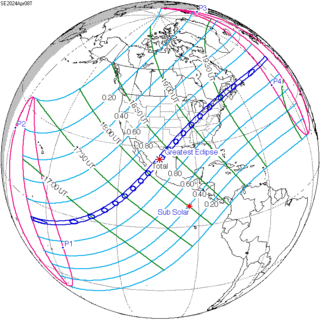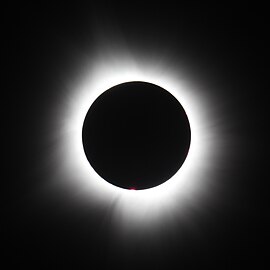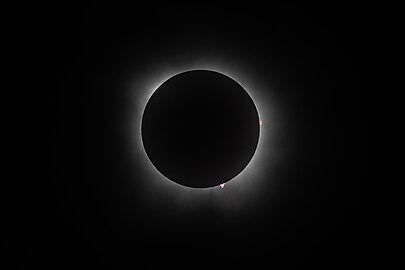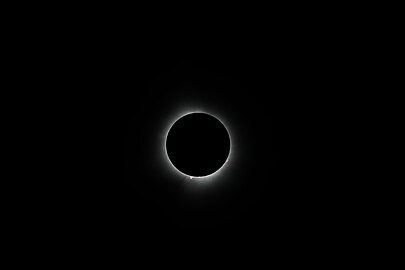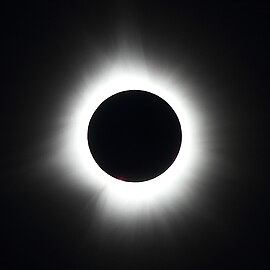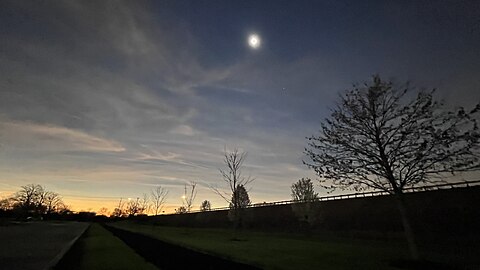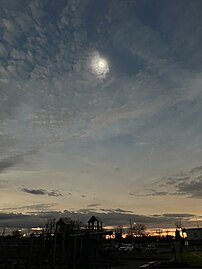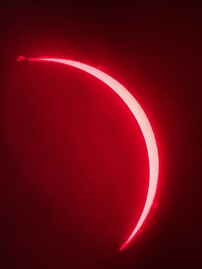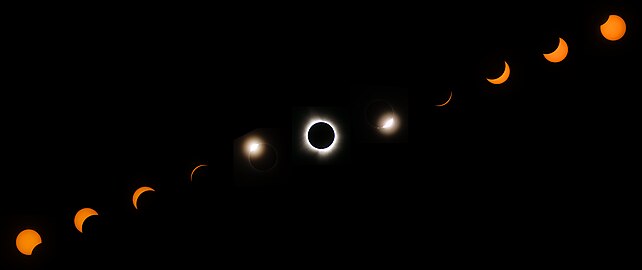Solar eclipse of April 8, 2024
| Solar eclipse of April 8, 2024 | |
|---|---|
 The solar eclipse during totality, seen from Dallas, Texas | |
| Type of eclipse | |
| Nature | Total |
| Gamma | 0.3431 |
| Magnitude | 1.0566 |
| Maximum eclipse | |
| Duration | 268 s (4 min 28 s) |
| Location | Nazas, Durango, Mexico |
| Coordinates | 25°18′N 104°06′W / 25.3°N 104.1°W |
| Max. width of band | 198 km (123 mi) |
| Times (UTC) | |
| (P1) Partial begin | 15:42:07 |
| (U1) Total begin | 16:38:44 |
| Greatest eclipse | 18:18:29 |
| (U4) Total end | 19:55:29 |
| (P4) Partial end | 20:52:14 |
| References | |
| Saros | 139 (30 of 71) |
| Catalog # (SE5000) | 9561 |
The solar eclipse of April 8, 2024, also known as the Great North American Eclipse,[1][2] was a total solar eclipse visible across a band covering parts of North America, from Mexico to Canada and crossing the contiguous United States. A solar eclipse occurs when the Moon passes between Earth and the Sun, thereby obscuring the Sun. A total solar eclipse occurs when the Moon's apparent diameter is larger than the Sun's, which blocks all direct sunlight and allows some of the Sun's corona and solar prominences to be seen. Totality occurs only in a limited path across Earth's surface, with the partial solar eclipse visible over a larger surrounding region.
During this eclipse, the Moon's apparent diameter was 5.5 percent larger than average due to occurring about a day after perigee. With a magnitude of 1.0566, the eclipse's longest duration of totality was 4 minutes and 28 seconds near the Mexican town of Nazas, Durango.[3][4]
This particular eclipse occurred at the Moon's ascending node of orbit. Totality was visible from 6 Mexican states, 15 U.S. states, and 6 Canadian provinces.[5] Approximately 44 million people lived in the path of totality, including 32 million in the United States, 6 million in Canada, and 6 million in Mexico.[6][7][8] The 10 largest cities in the path of totality accounted for a third of this population (5 of the 10 largest cities being in the United States, 3 in Mexico, and 2 in Canada).[9] Adding people who travelled to the path of totality, an estimated 50 million people experienced the total solar eclipse. [9] Meanwhile, about 652 million people experienced a partial solar eclipse.[6]
This eclipse was the first total solar eclipse visible from Canada since August 1, 2008, and from the provinces since February 26, 1979.[10][11] It was the first over Mexico since July 11, 1991.[12] It was also the first over the United States since August 21, 2017. This is the only solar eclipse in the 21st century with totality visible from all three countries.[13] The next total solar eclipse in the US will be on March 30, 2033, which will pass over Alaska. The next total eclipse in the contiguous United States of the US will be on August 23, 2044. The next total eclipse of similar width will take place on August 12, 2045, which will traverse coast-to-coast in a trajectory similar to the 2017 eclipse.
General path of shadow
[edit]
The totality of the solar eclipse was visible in a strip beginning in the Pacific Ocean, the edge of which passed approximately 60 kilometers north of Penrhyn atoll,[14] 115 kilometers south of Starbuck Island, 275 kilometers north of Vostok Island, and 370 kilometers north of the Marquesas Islands. Later, the total solar eclipse was visible from North America, starting from the west coast of Mexico then ascending in a northeasterly direction through Mexico, the United States, and Canada, before ending in the Atlantic Ocean about 700 kilometers southwest of Ireland.[15]
Visibility in the Americas
[edit]Mexico
[edit]Totality first passed over the Revillagigedo Islands (a federal possession of Mexico and associated with Colima state) and Islas Marías of Nayarit. Upon reaching the continental mainland, totality passed through the states of Sinaloa (including Mazatlán), northern Nayarit, Durango (including the city of Durango and Gómez Palacio), extreme southeast Chihuahua, and Coahuila (including Torreón, Matamoros, Monclova, Sabinas, Ciudad Acuña, and Piedras Negras).[16][17][18] A partial eclipse was visible across the remainder of the country, including 79% coverage of the solar disc in Mexico City.[19] Torreón was the most populous Mexican city in the path of totality.
United States
[edit]
In the United States, totality was visible through the states of Texas (including parts of San Antonio, Austin, Fort Worth, and all of Arlington, Dallas, Killeen, Temple, Texarkana, Tyler, Sulphur Springs, and Waco); Oklahoma (including Idabel and Broken Bow); Arkansas (including Morrilton/Petit Jean, Hot Springs, Searcy, Jonesboro, and Little Rock); Missouri (including Cape Girardeau and Poplar Bluff); Tennessee (extreme northwestern corner of Lake County); Illinois (including Carbondale, where it intersected the path of the 2017 eclipse); Kentucky; Indiana (including Bloomington, Evansville, Indianapolis, Anderson, Muncie, Terre Haute, and Vincennes); Ohio (including Akron, Cleveland, Dayton, Lima, Lorain, Roundhead,Toledo, and Warren); Michigan (extreme southeastern corner of Monroe County); Pennsylvania (including Erie); Upstate New York (including Buffalo, Niagara Falls, Rochester, Syracuse, Watertown, the Adirondacks, Potsdam, and Plattsburgh); northern Vermont (including Burlington); New Hampshire; and Maine;[20][21] with the line of totality going almost directly over the state's highest point Mount Katahdin. The largest city that was entirely in the path was Dallas, Texas.[22] It was the second total eclipse visible from the central United States in just seven years, after the eclipse of August 21, 2017. It was the last total solar eclipse visible in the contiguous United States until August 23, 2044.[23]
A partial solar eclipse was visible in all of the other parts of the contiguous United States, Hawaii, and southeast Alaska (Alaska Panhandle).[24]
Delta Air Lines scheduled two special eclipse-following flights: one from Austin to Detroit on a large-window A220-300, and one from Dallas to Detroit. [25] Various other flights in the path of totality also avoided cloud cover entirely.[26]
Canada
[edit]In Canada, totality was visible through parts of Southern Ontario (including Leamington, Fort Erie,[27] Hamilton, Niagara Falls, Kingston, Prince Edward County, and Cornwall),[28] parts of southern Quebec (including Montreal, Sherbrooke, Saint-Georges, and Lac-Mégantic), central New Brunswick (including Fredericton, Woodstock and Miramichi),[29] western Prince Edward Island (including Tignish and Summerside),[30][31] the northern tip of Cape Breton Island, Nova Scotia,[32] and central Newfoundland (including Gander and Grand Falls-Windsor). Then, it ended on the eastern Atlantic coast of Newfoundland.[33] The most populous Canadian city that the path of totality intersected was Montreal. Windsor, London, Toronto, and Ottawa lay just north of the path of totality, and Moncton just south of it.[34][35]
A partial solar eclipse was visible in all of the other parts of Canada, except the western part of Yukon and the western tip of the Northwest Territories.[36][37]
Boat cruises to observe the eclipse were conducted on Lake Erie, Niagara River, Lake Ontario, and Saint Lawrence River.[38]
Central America and South America
[edit]The partial eclipse was seen in all Central American countries, from Belize to Panama, all the Greater Antilles (Cuba, Dominican Republic, Haiti, Puerto Rico, and Jamaica), and northern South America (Colombia).[24]
Largest cities and recommended viewing sites
[edit]Space.com identified the ten largest cities where totality was visible. In population order, they were:[9]
Astronomy magazine provided a list of 20 recommended viewing sites, based on factors such as proximity to the center line, population size, ease of access, and so on. They were ordered from west to east:[39]
- Mazatlán, Sinaloa
- Nazas, Durango
- Piedras Negras, Coahuila
- Radar Base, Texas
- Kerrville, Texas
- Lampasas, Texas
- Hillsboro, Texas
- Sulphur Springs, Texas
- Russellville, Arkansas
- Cape Girardeau, Missouri
- Vincennes, Indiana
- Indianapolis, Indiana
- Lima, Ohio
- Cleveland, Ohio
- Erie, Pennsylvania
- Niagara Falls, New York
- Buffalo, New York
- Plattsburgh, New York
- Sherbrooke, Quebec
- Mars Hill, Maine
Visibility in other continents
[edit]
Europe
[edit]A partial eclipse passed over Svalbard (Norway), Iceland, Ireland, western parts of the United Kingdom, north-western parts of Spain and Portugal, the Azores, and the Canary Islands.[40] Cloud cover prevented views of it from most of the British Isles,[41][42] although it was seen in Western Scotland.[43] Unusually, this eclipse extended below the horizon, where the greatest phase was observed at mid-nautical twilight in Galicia (Spain) and the beginning of astronomical twilight in Nouvelle-Aquitaine (France).[44] The extension of the eclipse path within the twilight zone created what was likely the best observation window for the 12P/Pons–Brooks comet located closely to Jupiter.[45]
Oceania
[edit]The partial eclipse was seen in Hawaii, eastern Kiribati (the eastern Phoenix Islands and the whole Line Islands), Tokelau, American Samoa except for its extreme western part, the Cook Islands, French Polynesia, and the Pitcairn Islands. Although all located east of the 180th meridian, the local time of the eclipse in Kiribati and Tokelau was Tuesday, April 9, 2024, because either UTC+13 or UTC+14 is observed in these areas.[46][47][48]
Characteristics
[edit]Magnitude
[edit]The magnitude of an eclipse, or the ratio of the angular diameter of the Moon to the angular diameter of the Sun, must be one or greater for a total eclipse to occur. The Moon was near perigee (the closest point in its orbit to Earth) during this eclipse. Occurring only about 24 hours after perigee (on April 7, 2024, at 18:50 UTC), the Moon's apparent diameter was larger.[49] The Sun had an angular diameter of 31'56" at the moment of greatest eclipse. As the magnitude of this eclipse at that time was 1.0566, the angular diameter of the Moon was 1.0566 times that of the Sun, or 33'44". This gave the eclipse a wider path of totality and more maximum time in totality (4 min 28 s) compared to the total eclipse in 2017 (2 min 40 s), which had a magnitude of 1.0306.
Solar prominences
[edit]The eclipse occurred around the solar maximum, a period of greatest solar activity in the Sun's 11-year solar cycle, and it was anticipated that solar prominences would be visible during totality.[50] Many observers reported seeing solar prominences during the event.[51][52][53] Most plainly visible to the naked eye was a very bright red point of light near the lowest portion of the Sun's disk, which on telescopic views and photographs showed as a tent-shaped angular structure. The red and pink hues were the result of hydrogen and helium plasma being thrown up in broad arcs but never leaving the sun's atmosphere.[54][55] Telescopic photographs revealed the western limb having several smaller, irregular shapes, of which one large, ragged shape appeared disconnected from the Sun's surface on one side. Several smaller prominences were also visible on the eastern limb, though because of the eclipse's relatively high magnitude, prominences on both limbs could not be viewed at the same time. These shapes correlate in detail with the NASA Solar Dynamics Observatory solar telescope images taken in space at the same as the earthbound eclipse, and with images from the ground-based National Solar Observatory GONG telescope in Cerro Tololo, Chile.
Shadow bands
[edit]The shadow bands phenomenon was observed and documented in some locations with clear skies. Attempts to observe and record shadow bands on the ground were disappointed in many areas of totality by the phenomenon not appearing in the event, perhaps having been washed out by the diffuse illumination of cloudy skies in various locations.[56][57]
Eclipse path intersections
[edit]The path of the April 8, 2024, eclipse crossed the path of the previous American total solar eclipse of August 21, 2017, with the intersection of the two paths being in southern Illinois, in Makanda, just south of Carbondale.[58]
The path of the April 8 eclipse also crossed the path of the annular solar eclipse that occurred less than 6 months prior, on October 14, 2023, intersecting in the vicinity of San Antonio, Texas.[59]
Impact
[edit]Economy and tourism
[edit]It was projected before the eclipse that there could be a $6 billion boost to the US economy due to the eclipse. The Mayor of Rochester, New York, Malik Evans, told reporters that the city was expected to bring in between $10–12 million to the city's economy from the Friday before the eclipse to the day of it.[60][61] However, the day was cloudy. On April 12 New York Governor Kathy Hochul announced record breaking tourism numbers between April 6-9, that was a 45% increase compared to 2023, with nearly one million visitors to New York State parks and over 5.5 million toll transactions recorded.[62]
One company that tracks Airbnb data likened the economic impact of the event to having Taylor Swift's concerts taking place simultaneously in every city along the eclipse's path. In the United States, the prices of motels and hotels near the path of totality increased up to 100 percent on April 7 and April 8. Montreal saw a 20% surge in hotel occupancy for April 7 and April 8.[63][64][65]
The eclipse caused a drop in solar power generation, with Texas experiencing a decrease from 12,000 MW to just over 3,000 MW at 2 p.m. Wind power generation also decreased by about 50% that day. However, there were no disruptions in power distribution as supply exceeded demand.[66]
At Yankee Stadium, the Yankees gave away eclipse T-shirts to the first 15,000 fans at the game that day. The eclipse had pushed the start time back by four hours.[67]
Traffic
[edit]
Highways in the area of totality saw significant increases in traffic, with departing tourists caught in traffic jams lasting up to eight hours.[69] Many of those trying to drive down Interstate 93 in New Hampshire, for example, found themselves in jams lasting until at least 2 a.m. the following morning, resulting in numerous cars breaking down.[70] Drivers and passengers spent four to six hours to pass through Franconia Notch where Interstate 93 is reduced to a single lane in each direction. Major highways in the state remained crowded through rush hour the following morning and into the afternoon.[71] A similar effect was seen during the following morning's rush hour in northbound Interstate 65 in Indianapolis.[72] In Vermont there were an estimated 60,000 additional cars and 248 inbound aircraft over the span of the eclipse weekend, with about 160,000 visitors coming into the state per Secretary of Transportation Joe Flynn.[73] Drivers in southern Illinois leaving the region of totality to the north toward St. Louis, Missouri faced more than 80 miles of stop-and-go heavy congestion.[74] Unlike other regions, traffic was lighter in Texas than the state's Department of Transportation had anticipated.[68]
Animal behavior
[edit]Zookeepers, naturalists, university researchers, and citizen scientists positioned themselves to observe animal behavior during the eclipse, some with the goal of comparing results with observations made during the 1932 and 2017 total solar eclipses, and others opening new avenues of animal behavioral research. Wildlife and zoo animals were observed along the path of totality and in areas that saw only a partial eclipse. NASA worked with ARISA Lab, LLC, to recruit thousands of citizen scientists to help record sounds and observations of animal behavior during the eclipse. As of 16 April 2024[update], a total of 3,372 written observations had been submitted by citizen scientists, and 770 recording devices had been registered with the project to provide sound and ultrasound recordings of wildlife and other ambient sounds before, during, and after the eclipse in a standardized way.[75]
Wildlife
[edit]
Changes in wild animal behavior were recorded during the eclipse, especially among birds. These changes were similar to those observed during the 2017 eclipse, but more pronounced.[76] Weather radar was adapted to monitor the activity of flying animals, and birds were observed to decrease their daytime activities.[76] Radar imaging demonstrated "noticeable decreases in typical daytime biological activities such as the movements of hawks and other soaring and insect-eating birds."[76] Owls began hooting, and vultures and other birds began to roost.[77] A team from Purdue University, observing a variety of ecosystems on wild-lands maintained by the university near Butlerville, Indiana, recorded the songs of 20 different species of birds going quiet, leaving only the songs of the robin and the tufted titmouse during the eclipse.[78] Birding students at the University of Vermont observed species at Lake Champlain during the eclipse that had not been observed there before, including Bohemian waxwings, red-tailed hawks, and pileated woodpeckers.[79]
Insects and frogs in the wild were also observed making their nighttime sounds.[77] Cicadas in Arizona stopped singing when the Sun was 50% blocked during their partial eclipse.[80] Spring peepers, a type of nocturnal frog, were heard intermittently by the Purdue team in rural Indiana while the eclipse was partial, but they abruptly filled the soundscape at the moment of totality.[78] Wild cricket frogs were observed in Fort Worth, Texas, behaving similarly.[81]
Zoo animals
[edit]At the Columbus Zoo and Aquarium, ostriches returned to their barn and began their evening rituals, such as preening and grooming each other. When the sunlight returned, the ostriches left their barn and resumed their daytime activities.[82] A group of elephants at the zoo gathered together and began thumping their trunks on the ground.[82] At the Fort Worth Zoo in Texas, flamingos bunched together, vocalized, and began marching together, which is a bonding behavior.[80] A troop of gorillas at that zoo also gathered at the door to their indoor enclosure, where they were normally fed each evening, and appeared to act confused and frustrated, as if having missed their evening meal.[83][80] The Fort Worth Botanic Garden (FWBG) placed hundreds of butterflies in their conservatory March 1, allowed them to acclimate, and observed them during the eclipse. The butterflies "didn't roost but instead ceased flying and remained very still."[81] Goats at the FWBC were observed resting or sleeping during the eclipse.[81] Giraffes at the Dallas Zoo also began to gallop, a behavior witnessed there and at many other zoos during the 2017 eclipse.[83] Two aldabra tortoises at the same zoo were observed to rear on their hind legs and attack the door to their indoor enclosure, damaging the door's frame.[83] Lions at the Buffalo Zoo started roaring just before totality.[84]
Not all zoo animals reacted to the eclipse, nor did researchers expect them to. During the 2017 eclipse, researchers at the Riverbanks Zoo in South Carolina observed behavior changes in about 75% of species.[80][85] Adam Hartstone-Rose, a biology professor at North Carolina State University, hypothesized that the captive animals that did react may have been responding to the emotions of human zoo visitors.[83] Zoologists and volunteers at Parc Safari, a zoo in Hemmingford, Quebec, noted very little change in the animals they observed there, including giraffes, lions, hyenas, wolves, lynx, llamas, alpacas, and dromedaries. Hyenas vocalized during the eclipse, but there were other coinciding events that might have contributed to that behavior.[86] The zoo's director of zoology, Aurélien Berthelot, did not expect much activity from their mammals. For example, lions sleep up to eighteen hours per day. Some roared during the eclipse while others slept. Analyses of their observations are continuing.[86]
Responses
[edit]
Arkansas Governor Sarah Huckabee Sanders preemptively declared a state of emergency related to the eclipse, citing the expected increase of travel to the state which could result in transportation difficulties, such as in Fort Smith, where the police prepared for traffic congestion as hotels filled up.[88][89] Bell County, Texas Judge David Blackburn preemptively declared a state of emergency in February 2024 due to the projected number of visitors to the area.[90] The region surrounding Niagara Falls, Ontario, also declared a state of emergency; as an existing major tourist destination along the path of totality, it expected an influx of at least one million visitors on April 8.[91]
A lawsuit was filed on April 2 by six inmates of various religions at Woodbourne Correctional Facility in New York against the state, stating that the decision to lock down the prison during the eclipse conflicted with their religious beliefs. The solar eclipse is important in various religions.[92] The state settled the lawsuit by allowing them to view the eclipse.[93]
Gallery
[edit]Total
[edit]-
Totality as seen from Victoria de Durango, Durango
-
Totality as seen from Viesca, Coahuila
-
Totality as seen from Russellville, Arkansas
-
Totality with Venus near the lower right corner, as seen from Vienna, Illinois
-
Totality as seen from Crab Orchard National Wildlife Refuge, Illinois
-
Totality as seen from Speedway, Indiana
-
Totality as seen from Indianapolis, Indiana
-
Totality as seen from Cleveland, Ohio
-
Totality as seen from Harborcreek, Pennsylvania
-
Totality as seen from James N. Allan Provincial Park, Ontario
-
Quadcopter transits during totality from Newport, Vermont
-
Totality as seen from Greenville, Maine
-
Totality as seen from Jackman, Maine
Total with scenery
[edit]-
Totality over Evansville, Indiana
-
Totality over the Indianapolis Motor Speedway's flag stand
-
Totality over Sidney, Ohio
-
Overhead view of downtown Norwalk, Ohio during totality
-
Totality over Ripley, New York
-
Totality over Derby, Vermont
Partial
[edit]-
Partial as seen from San Nicolás de los Garza, Nuevo León
-
Partial as seen from Santa Ana, California
-
Partial as seen from Indianapolis, Indiana
-
Partial as seen from Lexington, Kentucky
-
Partial as seen from Washington, D.C. above the Washington Monument
-
Partial as seen from Southeastern Pennsylvania
-
Partial as seen from Plainfield, New Jersey
-
Partial as seen from Jackman, Maine
-
Partial as seen from Dexter, Ontario
-
Post-totality diamond-ring effect as seen from Montreal, Quebec
Composites
[edit]-
Eclipse progression as seen from Vincennes, Indiana
-
Eclipse progression as seen from Indianapolis, Indiana
-
Eclipse progression to totality as seen from Cleveland, Ohio
-
Eclipse progression as seen from Newport, Vermont
-
Composite image of totality as seen from a location in Canada reveals the corona
-
Eclipse progression as seen from Québec City, Quebec
Projections
[edit]-
Photograph of the eclipse projected with binoculars in Puebla, Mexico
-
Photograph of the eclipse projected with binoculars in Puebla, Mexico
-
Leaf shadow projection of the eclipse in College Station, Texas
-
Cardboard box pinhole projection of the eclipse in Dallas, Texas
-
Camera obscura projection of the eclipse in Danville, Arkansas
-
Colander projection of the eclipse in Corning, Arkansas
-
Interlaced finger projection of the eclipse in Marion, Illinois
Eclipse details
[edit]Shown below are two tables displaying details about this particular solar eclipse. The first table outlines times at which the moon's penumbra or umbra attains the specific parameter, and the second table describes various other parameters pertaining to this eclipse.[94]
| Event | Time (UTC) |
|---|---|
| First Penumbral External Contact | 2024 April 08 at 15:43:23.3 UTC |
| First Umbral External Contact | 2024 April 08 at 16:40:00.7 UTC |
| First Central Line | 2024 April 08 at 16:41:09.4 UTC |
| First Umbral Internal Contact | 2024 April 08 at 16:42:18.1 UTC |
| First Penumbral Internal Contact | 2024 April 08 at 17:46:09.2 UTC |
| Greatest Eclipse | 2024 April 08 at 18:18:29.4 UTC |
| Greatest Duration | 2024 April 08 at 18:20:44.2 UTC |
| Ecliptic Conjunction | 2024 April 08 at 18:22:00.8 UTC |
| Equatorial Conjunction | 2024 April 08 at 18:37:18.9 UTC |
| Last Penumbral Internal Contact | 2024 April 08 at 18:50:23.9 UTC |
| Last Umbral Internal Contact | 2024 April 08 at 19:54:30.4 UTC |
| Last Central Line | 2024 April 08 at 19:55:38.1 UTC |
| Last Umbral External Contact | 2024 April 08 at 19:56:45.7 UTC |
| Last Penumbral External Contact | 2024 April 08 at 20:53:30.4 UTC |
| Parameter | Value |
|---|---|
| Eclipse Magnitude | 1.05656 |
| Eclipse Obscuration | 1.11631 |
| Gamma | 0.34314 |
| Sun Right Ascension | 01h11m36.9s |
| Sun Declination | +07°35'29.4" |
| Sun Semi-Diameter | 15'58.2" |
| Sun Equatorial Horizontal Parallax | 08.8" |
| Moon Right Ascension | 01h10m57.5s |
| Moon Declination | +07°53'55.5" |
| Moon Semi-Diameter | 16'36.3" |
| Moon Equatorial Horizontal Parallax | 1°00'56.6" |
| ΔT | 71.5 s |
Eclipse season
[edit]This eclipse is part of an eclipse season, a period, roughly every six months, when eclipses occur. Only two (or occasionally three) eclipse seasons occur each year, and each season lasts about 35 days and repeats just short of six months (173 days) later; thus two full eclipse seasons always occur each year. Either two or three eclipses happen each eclipse season. In the sequence below, each eclipse is separated by a fortnight.
| March 25 Descending node (full moon) |
April 8 Ascending node (new moon) |
|---|---|
 |
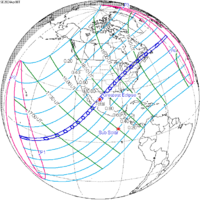
|
| Penumbral lunar eclipse Lunar Saros 113 |
Total solar eclipse Solar Saros 139 |
Related eclipses
[edit]Eclipses in 2024
[edit]- A penumbral lunar eclipse on March 25.
- A total solar eclipse on April 8.
- A partial lunar eclipse on September 18.
- An annular solar eclipse on October 2.
Metonic
[edit]- Preceded by: Solar eclipse of June 21, 2020
- Followed by: Solar eclipse of January 26, 2028
Tzolkinex
[edit]- Preceded by: Solar eclipse of February 26, 2017
- Followed by: Solar eclipse of May 21, 2031
Half-Saros
[edit]- Preceded by: Lunar eclipse of April 4, 2015
- Followed by: Lunar eclipse of April 14, 2033
Tritos
[edit]- Preceded by: Solar eclipse of May 10, 2013
- Followed by: Solar eclipse of March 9, 2035
Solar Saros 139
[edit]- Preceded by: Solar eclipse of March 29, 2006
- Followed by: Solar eclipse of April 20, 2042
Inex
[edit]- Preceded by: Solar eclipse of April 29, 1995
- Followed by: Solar eclipse of March 20, 2053
Triad
[edit]- Preceded by: Solar eclipse of June 8, 1937
- Followed by: Solar eclipse of February 8, 2111
Solar eclipses of 2022–2025
[edit]This eclipse is a member of a semester series. An eclipse in a semester series of solar eclipses repeats approximately every 177 days and 4 hours (a semester) at alternating nodes of the Moon's orbit.[95]
| Solar eclipse series sets from 2022 to 2025 | ||||||
|---|---|---|---|---|---|---|
| Ascending node | Descending node | |||||
| Saros | Map | Gamma | Saros | Map | Gamma | |
119 Partial in CTIO, Chile |
April 30, 2022 Partial |
−1.19008 | 124 Partial from Saratov, Russia |
October 25, 2022 Partial |
1.07014 | |
129 Partial in Magetan, Indonesia |
April 20, 2023 Hybrid |
−0.39515 | 134 Annularity in Hobbs, NM, USA |
October 14, 2023 Annular |
0.37534 | |
139 Totality in Dallas, TX, USA |
April 8, 2024 Total |
0.34314 | 144 Annularity in Santa Cruz Province, Argentina |
October 2, 2024 Annular |
−0.35087 | |
| 149 | March 29, 2025 Partial |
1.04053 | 154 | September 21, 2025 Partial |
−1.06509 | |
Saros 139
[edit]This eclipse is a part of Saros series 139, repeating every 18 years, 11 days, and containing 71 events. The series started with a partial solar eclipse on May 17, 1501. It contains hybrid eclipses from August 11, 1627 through December 9, 1825 and total eclipses from December 21, 1843 through March 26, 2601. There are no annular eclipses in this set. The series ends at member 71 as a partial eclipse on July 3, 2763. Its eclipses are tabulated in three columns; every third eclipse in the same column is one exeligmos apart, so they all cast shadows over approximately the same parts of the Earth.
The longest duration of totality will be produced by member 61 at 7 minutes, 29.22 seconds on July 16, 2186. This date is the longest solar eclipse computed between 4000 BC and AD 6000.[96] All eclipses in this series occur at the Moon’s ascending node of orbit.[97]
| Series members 18–39 occur between 1801 and 2200: | ||
|---|---|---|
| 18 | 19 | 20 |
 November 29, 1807 |
 December 9, 1825 |
 December 21, 1843 |
| 21 | 22 | 23 |
 December 31, 1861 |
 January 11, 1880 |
 January 22, 1898 |
| 24 | 25 | 26 |
 February 3, 1916 |
 February 14, 1934 |
 February 25, 1952 |
| 27 | 28 | 29 |
 March 7, 1970 |
 March 18, 1988 |
 March 29, 2006 |
| 30 | 31 | 32 |
 April 8, 2024 |
 April 20, 2042 |
 April 30, 2060 |
| 33 | 34 | 35 |
 May 11, 2078 |
 May 22, 2096 |
 June 3, 2114 |
| 36 | 37 | 38 |
 June 13, 2132 |
 June 25, 2150 |
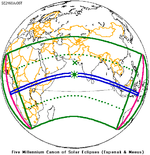 July 5, 2168 |
| 39 | ||
 July 16, 2186 | ||
Metonic series
[edit]The metonic series repeats eclipses every 19 years (6939.69 days), lasting about 5 cycles. Eclipses occur in nearly the same calendar date. In addition, the octon subseries repeats 1/5 of that or every 3.8 years (1387.94 days). All eclipses in this table occur at the Moon's ascending node.
| 21 eclipse events between June 21, 1982 and June 21, 2058 | ||||
|---|---|---|---|---|
| June 21 | April 8–9 | January 26 | November 13–14 | September 1–2 |
| 117 | 119 | 121 | 123 | 125 |
 June 21, 1982 |
 April 9, 1986 |
 January 26, 1990 |
 November 13, 1993 |
 September 2, 1997 |
| 127 | 129 | 131 | 133 | 135 |
 June 21, 2001 |
 April 8, 2005 |
 January 26, 2009 |
 November 13, 2012 |
 September 1, 2016 |
| 137 | 139 | 141 | 143 | 145 |
 June 21, 2020 |
 April 8, 2024 |
 January 26, 2028 |
 November 14, 2031 |
 September 2, 2035 |
| 147 | 149 | 151 | 153 | 155 |
 June 21, 2039 |
 April 9, 2043 |
 January 26, 2047 |
 November 14, 2050 |
 September 2, 2054 |
| 157 | ||||
 June 21, 2058 | ||||
Tritos series
[edit]This eclipse is a part of a tritos cycle, repeating at alternating nodes every 135 synodic months (≈ 3986.63 days, or 11 years minus 1 month). Their appearance and longitude are irregular due to a lack of synchronization with the anomalistic month (period of perigee), but groupings of 3 tritos cycles (≈ 33 years minus 3 months) come close (≈ 434.044 anomalistic months), so eclipses are similar in these groupings.
| Series members between 1801 and 2200 | ||||
|---|---|---|---|---|
 December 21, 1805 (Saros 119) |
 November 19, 1816 (Saros 120) |
 October 20, 1827 (Saros 121) |
 September 18, 1838 (Saros 122) |
 August 18, 1849 (Saros 123) |
 July 18, 1860 (Saros 124) |
 June 18, 1871 (Saros 125) |
 May 17, 1882 (Saros 126) |
 April 16, 1893 (Saros 127) |
 March 17, 1904 (Saros 128) |
 February 14, 1915 (Saros 129) |
 January 14, 1926 (Saros 130) |
 December 13, 1936 (Saros 131) |
 November 12, 1947 (Saros 132) |
 October 12, 1958 (Saros 133) |
 September 11, 1969 (Saros 134) |
 August 10, 1980 (Saros 135) |
 July 11, 1991 (Saros 136) |
 June 10, 2002 (Saros 137) |
 May 10, 2013 (Saros 138) |
 April 8, 2024 (Saros 139) |
 March 9, 2035 (Saros 140) |
 February 5, 2046 (Saros 141) |
 January 5, 2057 (Saros 142) |
 December 6, 2067 (Saros 143) |
 November 4, 2078 (Saros 144) |
 October 4, 2089 (Saros 145) |
 September 4, 2100 (Saros 146) |
 August 4, 2111 (Saros 147) |
 July 4, 2122 (Saros 148) |
 June 3, 2133 (Saros 149) |
 May 3, 2144 (Saros 150) |
 April 2, 2155 (Saros 151) |
 March 2, 2166 (Saros 152) |
 January 29, 2177 (Saros 153) |
 December 29, 2187 (Saros 154) |
 November 28, 2198 (Saros 155) | |||
Inex series
[edit]This eclipse is a part of the long period inex cycle, repeating at alternating nodes, every 358 synodic months (≈ 10,571.95 days, or 29 years minus 20 days). Their appearance and longitude are irregular due to a lack of synchronization with the anomalistic month (period of perigee). However, groupings of 3 inex cycles (≈ 87 years minus 2 months) comes close (≈ 1,151.02 anomalistic months), so eclipses are similar in these groupings.
| Series members between 1801 and 2200 | ||
|---|---|---|
 August 27, 1821 (Saros 132) |
 August 7, 1850 (Saros 133) |
 July 19, 1879 (Saros 134) |
 June 28, 1908 (Saros 135) |
 June 8, 1937 (Saros 136) |
 May 20, 1966 (Saros 137) |
 April 29, 1995 (Saros 138) |
 April 8, 2024 (Saros 139) |
 March 20, 2053 (Saros 140) |
 February 27, 2082 (Saros 141) |
 February 8, 2111 (Saros 142) |
 January 20, 2140 (Saros 143) |
 December 29, 2168 (Saros 144) |
 December 9, 2197 (Saros 145) |
|
See also
[edit]References
[edit]- ^ "April 8, 2024 Total Solar Eclipse". timeanddate. Retrieved August 13, 2024.
- ^
- "Highlights from the total solar eclipse: Live videos, photos and updates". NBC News. April 8, 2024. Archived from the original on April 9, 2024. Retrieved April 10, 2024.
A total solar eclipse — nicknamed the Great North American Eclipse for its long path over North America
- Carter, Jamie (April 8, 2024). "Annular solar eclipse 2024: Everything you need to know about the next solar eclipse". Space.com. Archived from the original on April 9, 2024. Retrieved April 10, 2024.
The Oct. 2, 2024, annular solar eclipse is special for three very different reasons. First, it follows the Great North American Eclipse of April 8
- Klesman, Alison (April 5, 2024). "The Sky This Week from April 5 to 12: A Great North American Eclipse". Astronomy. Archived from the original on April 8, 2024. Retrieved April 10, 2024.
- Achenbach, Joel (April 7, 2024). "The total solar eclipse is finally here. Will the clouds be here, too?". The Washington Post. Retrieved April 10, 2024.
The Great North American Eclipse of 2024 is a continent-scale event.
- "Highlights from the total solar eclipse: Live videos, photos and updates". NBC News. April 8, 2024. Archived from the original on April 9, 2024. Retrieved April 10, 2024.
- ^ Spanner, Holly (April 5, 2024). "Solar eclipse 2024: How to see the biggest cosmic event of the year this April". Science Focus. BBC. Archived from the original on April 19, 2024. Retrieved April 19, 2024.
- ^ Rivera, Ramón (April 8, 2024). "Así se vivió el eclipse solar total en Nazas, epicentro en Durango". Milenio. Archived from the original on April 19, 2024. Retrieved April 19, 2024.
- ^ Carter, Jamie (March 27, 2024). "Will the total solar eclipse on April 8 be the most watched ever?". Space.com. Retrieved April 29, 2024.
- ^ a b "April 8, 2024 — Great North American Eclipse (Total Solar Eclipse)". timeanddate. Retrieved April 29, 2024.
- ^ "Total solar eclipse frenzy grips North America". Aljazeera.com. Aljazeera. April 8, 2024. Retrieved May 7, 2024.
- ^ "Are you among the one in six near the eclipse?". StatsCAN Plus. Statistics Canada. April 4, 2024. Retrieved April 29, 2024.
- ^ a b c Carter, Jamie (January 1, 2024). "Total solar eclipse April 2024: 10 of the biggest cities within the path of totality". Space.com. Retrieved April 29, 2024.
- ^ Aziz, Saba (February 12, 2024). "Total solar eclipse: All you need to know about the rare celestial event". Global News. Archived from the original on February 13, 2024. Retrieved February 13, 2024.
- ^ Dickinson, Terence (August 3, 2017). "Canada's last solar eclipse in 1979". Maclean's. Archived from the original on August 12, 2017. Retrieved August 24, 2017.
- ^ Total Solar Eclipse in Mexico, 1991 (in Spanish). National Autonomous University of Mexico. 1991. ISBN 9789683617613. Archived from the original on February 15, 2023. Retrieved April 2, 2009.
- ^ "Location of Total Solar Eclipse of April 8, 2024". GreatAmericanEclipse.com. Archived from the original on August 26, 2017. Retrieved September 9, 2017.
- ^ "Penrhyn catches a glimpse of near-total eclipse despite cloudy skies". Cook Islands NEWS. April 9, 2024. Archived from the original on April 16, 2024. Retrieved April 19, 2024.
- ^ "Where & When". NASA. April 6, 2024. Archived from the original on April 8, 2024. Retrieved April 8, 2024.
- ^ "Total Solar Eclipse in Mexico". Time and Date. April 2024. Archived from the original on April 7, 2024. Retrieved April 7, 2024.
Total Solar Eclipse durations: Durango, Durango – 3m 47s; Mazatlan, Sinaloa – 4m 20s; Torreón, Coahuila de Zaragoza – 4m 9s.
- ^ Carter, Jamie (November 20, 2023). "The best places in Mexico to see the total solar eclipse on April 8, 2024". Space news. Archived from the original on April 6, 2024. Retrieved April 7, 2024.
Mazatlán, on the country's western coast, will be the first region of mainland Mexico to experience totality, followed by Durango, Torreón, and Monclova as the path tracks northeast toward the U .S. border at Piedras Negras.
- ^ "Solar Eclipse of April 8 2024 from Mazatlán, Mexico". The Sky Live. April 7, 2024. Archived from the original on April 7, 2024. Retrieved April 7, 2024.
A Total Eclipse of magnitude 1.0216 will be visible from Mazatlán, Mexico on April 8 2024. Maximum eclipse will be at 11:09:38 local time and totality duration will be 4m 19s.
- ^ "Gran Eclipse Mexicano 2024". Instituto de Geofísica, UNAM. Archived from the original on April 8, 2024. Retrieved April 8, 2024.
- ^ Gore, Leada (August 22, 2017). "Solar eclipse 2024: Best U.S. cities to see the next total solar eclipse". The Birmingham News. Archived from the original on February 12, 2018. Retrieved February 11, 2018.
- ^ Eliasen, Terry (August 21, 2017). "Next Solar Eclipse Puts New England in Path Of Totality". CBS Boston. Archived from the original on February 12, 2018. Retrieved February 11, 2018.
- ^ "Great North American Eclipse: Dallas". Perot Museum of Nature and Science. April 3, 2024. Archived from the original on April 7, 2024. Retrieved April 7, 2024.
On April 8, 20 24, Dallas will be the largest city in the path of totality for the once-in-a-lifetime Great North American Eclipse.
- ^ Hauari, Gabe; Lagatta, Eric (March 1, 2024). "When is the next total solar eclipse in the US after 2024? Here's what you need to know". USA Today. Archived from the original on April 8, 2024. Retrieved April 8, 2024.
- ^ a b "April 8, 2024 — Great North American Eclipse (Total Solar Eclipse)". timeanddate. Archived from the original on April 12, 2024. Retrieved April 13, 2024.
- ^ Lamothe, Jacqueline (April 8, 2024). "1 solar eclipse, 2 spectacular flights: How Delta people are preparing for the celestial event". Delta News Hub. Archived from the original on April 9, 2024. Retrieved April 8, 2024.
- ^ Diba Mohtasham (February 22, 2024). "Delta's special total solar eclipse flight sold out in 24 hours". NPR. Archived from the original on March 1, 2024. Retrieved March 1, 2024.
- ^ Jubier, Xavier (April 7, 2024). "Total Eclipse for Fort Erie, Canada". Google Maps. Archived from the original on April 8, 2024. Retrieved April 7, 2024.
Fort Erie totality 3m 46s.
- ^ Nielsen, Kevin (April 5, 2024). "Total solar eclipse: Where the best views in Ontario are expected to be". Global News. Archived from the original on April 7, 2024. Retrieved April 7, 2024.
Fort Erie will experience the longest totality at 3m 46s, with Niagara Falls following c losely at 3m 31s, both occurring at 3:20 pm.
- ^ Urquhart, Mia (January 22, 2024). "N.B. has front-row seat for 'once-in-a-lifetime' total solar eclipse on April 8". CBC News. Archived from the original on April 7, 2024. Retrieved April 7, 2024.
Fredericton, Woodstock, and Miramichi are in the 'path of totality'. Moncton and Saint John, just outside, had about 98% sun coverage.
- ^ Goodsell, Devon (September 5, 2022). "'Once-in-a-lifetime opportunity' to view 2024 total solar eclipse on P.E.I." CBC News. Archived from the original on April 7, 2024. Retrieved April 7, 2024.
Totality visible west of Summerside: 1m 2s. In Tignish, totality lasts 3m 12s.
- ^ "Timing of 2024 Solar Eclipse". University of Prince Edward Island. March 28, 2023. Archived from the original on April 7, 2024. Retrieved April 7, 2024.
Timing and duration of the total eclipse will vary slightly across the Island.
- ^ "NASA – Total Solar Eclipse of 2024 Apr 08". March 27, 2008. Archived from the original on March 27, 2008.
- ^ Jubier, Xavier (April 7, 2024). "The Eclipse vanishing off the eastern coast of Newfoundland, Canada". Google Maps. Archived from the original on April 8, 2024. Retrieved April 7, 2024.
Totality on the eastern coast of Newfoundland: 2m 53s.
- ^ Jubier, Xavier (April 7, 2024). "The Eclipse vanishing off the eastern coast of Newfoundland, Canada". Google Maps. Retrieved April 14, 2024.
Ottawa north of totality
- ^ Jubier, Xavier (April 7, 2024). "The Eclipse vanishing off the eastern coast of Newfoundland, Canada". Google Maps. Retrieved April 14, 2024.
Moncton slightly south of totality
- ^ Otis, Daniel (January 8, 2024). "How to watch a rare total solar eclipse across eastern Canada this year". CTV News. Canada. Archived from the original on April 8, 2024. Retrieved April 14, 2024.
- ^ Salim, Lidya (March 22, 2024). "What is a solar eclipse and how to observe it safely?". Science Rendezvous. Canada. Archived from the original on April 5, 2024. Retrieved April 14, 2024.
- ^ "Eclipse Cruise". Kingston, Canada. Retrieved April 20, 2024.
- ^ Bakich, Michael (April 8, 2024). "20 of the best places to view the 2024 total solar eclipse". Astronomy. Retrieved May 2, 2024.
- ^ "Eclipse Path of Total Solar Eclipse on April 8, 2024". www.timeanddate.com. Archived from the original on March 13, 2020. Retrieved April 10, 2020.
- ^ McDonagh, Darragh (April 8, 2024). "Cloud spoils solar eclipse for Irish stargazers". Daily Mirror. Archived from the original on April 9, 2024. Retrieved April 9, 2024.
- ^ Mucklejohn, Piers (April 8, 2024). "Clouds plague UK spectators as millions in US witness total solar eclipse". The Independent. Archived from the original on April 11, 2024. Retrieved April 11, 2024.
- ^ "Eclipse 2024: Partial eclipse seen in Scotland as most of UK misses out". BBC News. April 8, 2024. Archived from the original on April 9, 2024. Retrieved April 9, 2024.
- ^ "2024 solar eclipse in Europe". European Eclipse Quadruplet. Archived from the original on November 3, 2023. Retrieved November 3, 2023.
- ^ "12P/Pons Brooks comet during 2024 total solar eclipse". Astro-Geo-GIS.com. April 14, 2023. Archived from the original on October 26, 2023. Retrieved October 26, 2023.
- ^ "April 8, 2024 - Solar Eclipse - Honolulu, HI, USA". timeanddate. April 8, 2024. Archived from the original on March 29, 2024. Retrieved April 15, 2024.
- ^ "Apr 8, 2024 - Partial Solar Eclipse in American Samoa". timeanddate. April 8, 2024. Archived from the original on March 29, 2024. Retrieved April 15, 2024.
- ^ "April 9, 2024 - Solar Eclipse - Rawaki, Phoenix Islands, Kiribati". timeanddate. April 9, 2024. Archived from the original on June 6, 2023. Retrieved April 15, 2024.
- ^ "Moon Distances for London, United Kingdom, England". timeanddate. Retrieved August 13, 2024.
- ^ Carter, Jamie (March 23, 2023). "Massive explosions may be visible on the sun during the April 8 total solar eclipse". Space.com. Archived from the original on April 8, 2024. Retrieved April 8, 2024.
- ^ Bartels, Meghan (April 8, 2024). "What Were the Red Dots around the Total Solar Eclipse?". Scientific American. Archived from the original on April 9, 2024. Retrieved April 8, 2024.
- ^ Robledo, Anthony; Lagatta, Eric (April 8, 2024). "Solar flares reported during total eclipse as sun nears solar maximum. What are they?". USA Today. Archived from the original on April 9, 2024.
- ^ Bassler, Hunter; Allred, Anne (April 8, 2024). "Possible massive sun explosion captured on camera by Chicago eclipse viewer in Cape Girardeau". KSDK. Archived from the original on April 9, 2024. Retrieved April 8, 2024.
- ^ Bartels, Meghan (April 8, 2024). "What Were the Red Dots around the Total Solar Eclipse?". Scientific American. SCIENTIFIC AMERICAN, A DIVISION OF SPRINGER NATURE AMERICA, INC. Retrieved May 3, 2024.
- ^ Specktor, Brandon (April 14, 2024). "Space photo of the week: NASA spots enormous pink 'flames' during total solar eclipse. What are they?". Live Science. Future US, Inc. Retrieved May 3, 2024.
- ^ Sky Story (April 10, 2024). "Shadow Bands of a Solar Eclipse Racing Over Snow". YouTube. Archived from the original on April 15, 2024. Retrieved April 13, 2024.
- ^ Coleman, RG (April 10, 2024). "April 8, 2024—Eclipse Day, Lampasas, Texas". timeanddate. Archived from the original on April 13, 2024. Retrieved April 15, 2024.
no approaching moon's shadow, no shadow bands
- ^ "Total Solar Eclipse 2017 – Path Overlap with the 2024 Eclipse". eclipse2017.org. Archived from the original on September 3, 2017. Retrieved September 1, 2017.
- ^ "2 Great Texan Eclipses". greatamericaneclipse.com. Archived from the original on April 8, 2024. Retrieved April 15, 2024.
- ^ Sherter, Aimee (April 6, 2024). "The solar eclipse could deliver a $6 billion economic boom: "The whole community is sold out"". CBS News. Archived from the original on April 14, 2024. Retrieved April 15, 2024.
- ^ Kekatos, Mary (April 5, 2024). "How Rochester, New York, hopes the eclipse brings a lasting economic boom to city". ABC News. Archived from the original on April 8, 2024. Retrieved April 8, 2024.
- ^ "NY saw record tourism numbers for eclipse, despite cloudy conditions in WNY". Orleans Hub. April 12, 2024. Retrieved April 13, 2024.
- ^ Raymond, Art (April 9, 2024). "The Taylor Swift effect? Eclipse spending may top $6 billion". Yahoo Finance.
- ^ "Total Solar Eclipse Causes Surge in Pricing and Demand for Hotels, Airbnbs: What to Know as a Traveler". Peoplemag. April 5, 2024. Archived from the original on April 8, 2024. Retrieved April 8, 2024.
- ^ Rassy, Swidda (April 8, 2024). "Tourism up in Montreal due to total solar eclipse". Archived from the original on April 9, 2024. Retrieved April 9, 2024.
- ^ "NREL Shows Live Grid Impacts From Total Solar Eclipse". National Renewable Energy Laboratory. April 8, 2024. Retrieved October 28, 2024.
- ^ "Yankees-Marlins start time pushed back due to solar eclipse". Fox5NY. Associated Press. April 5, 2024. Retrieved August 9, 2024.
- ^ a b "Where was all the anticipated eclipse traffic?". Texas Wants To Know/KRLD News Radio. 121cast Pty Ltd. Retrieved April 30, 2024.
- ^ Smart, Charlie (April 10, 2024). "See Maps of Where Eclipse Seekers Flocked and the Traffic That Followed". The New York Times. Archived from the original on April 11, 2024. Retrieved April 11, 2024.
- ^ Perry, Nick; McCormack, Kathy (April 9, 2024). "Many eclipse visitors to northern New England pulled an all-nighter trying to leave". The Associated Press. Archived from the original on April 9, 2024. Retrieved April 10, 2024.
- ^ Bottari, Steve (April 9, 2024). "Eclipse traffic fallout: NHDOT responds to criticism following hours-long delays". WMUR9. Retrieved April 30, 2024.
- ^ Christy, Matt (April 8, 2024). "Eclipse traffic clogs up Indianapolis area roads". Fox 9 News. Nexstar Media, Inc. Retrieved April 30, 2024.
- ^ Dockser, Corey (April 10, 2024). "Vermont's eclipse in (preliminary) numbers: 160,000 visitors, 60,000 cars". Vermont Public. Archived from the original on April 11, 2024. Retrieved April 13, 2024.
- ^ Coronel, Justina (April 9, 2024). "'I'd sit in this traffic 10x to see that eclipse again!': Eclipse viewers stuck in traffic for hours". 5 on Your Side. KSDK-TV. Retrieved April 30, 2024.
- ^ "Eclipse Soundscapes Project". EclipseSoundscapes.org. ARISA Lab, LLC with support from NASA. Retrieved May 1, 2024.
- ^ a b c Leonard, Pat. "Early analysis finds eclipse had noticeable effect on birds". phys.org. Science X. Retrieved April 26, 2024.
- ^ a b Thomson, Jess (April 24, 2024). "Owls Started Hooting During the Solar Eclipse As If They Were About To Hunt". Newsweek. NEWSWEEK DIGITAL LLC. Retrieved April 26, 2024.
- ^ a b Gamillo, Elizabeth (April 18, 2024). "While millions watched the eclipse, these Purdue University scientists listened". Astronomy.com. Kalmbach Media. Retrieved April 26, 2024.
- ^ Marchesani, Gabriella. "The Tourism of Totality: Lake Champlain Reacts to Total Solar Eclipse and Preps for Earth Day Activities". Sea Grany Lake Champlain. University of Vermont. Retrieved April 26, 2024.
- ^ a b c d Carroll, Mickey. "Animals reacted weirdly to the eclipse and NASA wants your help studying them". Sky News Science and Tech. Sky News. Retrieved April 26, 2024.
- ^ a b c Bales, Ashley (April 19, 2024). "Eclipse in the Garden: Recapping Community Science Involvement". Fort Worth Botanic Garden. Retrieved April 26, 2024.
- ^ a b Rogner, Carla (April 8, 2024). "Elephants, ostriches had biggest reactions to eclipse at the Columbus Zoo". WTHR. Retrieved April 26, 2024.
- ^ a b c d Fink, Kathryn; Ermyas, Tinbete; Summers, Juana. "Animals are stressed during eclipses. But not for the reason you think". NPR. Retrieved April 26, 2024.
- ^ Pankiewicz, Colton; Joly, Aidan (April 8, 2024). "Buffalo Zoo creates a unique experience for eclipse watchers". News 4 Buffalo. Nexstar Media Inc. Retrieved April 30, 2024.
- ^ "Solar eclipse 2024: Nasa studying how animals reacted to the eclipse". BBC Newsround. BBC. April 22, 2024. Retrieved April 26, 2024.
- ^ a b Rennie, Sarah (April 17, 2024). "Parc Safari animals turn a blind eye to the eclipse". The Gleaner. Retrieved April 26, 2024.
- ^ "Total Solar Eclipse Darkens North America". earthobservatory.nasa.gov. April 9, 2024. Archived from the original on April 10, 2024. Retrieved April 11, 2024.
- ^ Rains, Brett (April 4, 2024). "Fort Smith police prepare for traffic congestion as hotels fill up for the eclipse". KHBS. Archived from the original on April 6, 2024. Retrieved April 8, 2024.
- ^ Sosa, Abner (April 6, 2024). "Gov. Sarah Huckabee Sanders declares state of emergency ahead of solar eclipse". KHBS. Archived from the original on April 7, 2024. Retrieved April 7, 2024.
- ^ Flores, Bri; Audacy • •, Chris Blake | (April 7, 2024). "How will eclipse-driven tourism impact the Texas economy?". NBC 5 Dallas-Fort Worth. Archived from the original on April 7, 2024. Retrieved April 8, 2024.
- ^ Li, Justin (March 30, 2024). "Niagara Falls declares state of emergency in advance of huge influx of eclipse visitors". CBC News. Archived from the original on April 7, 2024. Retrieved April 8, 2024.
- ^ Lagetta, Eric (April 2, 2024). "New York inmates say a prison lockdown for the eclipse violates their religious freedoms: Lawsuit". USA Today. Archived from the original on April 8, 2024. Retrieved April 8, 2024.
- ^ Helsel, Phil; McLaughlin, Evan (April 4, 2024). "Inmates at New York prison will get to watch eclipse after all". NBC News. Archived from the original on April 8, 2024. Retrieved April 8, 2024.
- ^ "Total Solar Eclipse of 2024 Apr 08". EclipseWise.com. Retrieved August 13, 2024.
- ^ van Gent, R.H. "Solar- and Lunar-Eclipse Predictions from Antiquity to the Present". A Catalogue of Eclipse Cycles. Utrecht University. Retrieved October 6, 2018.
- ^ Ten Millennium Catalog of Long Solar Eclipses, −3999 to +6000 (4000 BCE to 6000 CE) Fred Espenak.
- ^ "NASA - Catalog of Solar Eclipses of Saros 139". eclipse.gsfc.nasa.gov.
External links
[edit]- 2024 Total Solar Eclipse – CNN
- Besselian Elements for the Total Solar Eclipse of 2024 Apr 08
- Hermit Eclipse: Total Solar Eclipse April 8, 2024
- Eclipse Simulator from Eclipse2024.org
- Live broadcast of the eclipse at NASA website
- Live broadcast of the eclipse at Virtual Telescope Project website
- Live coverage in Texas and Mexico, including full telescope videos, by the Exploratorium

